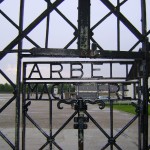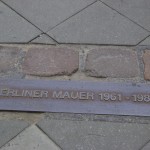“Immediately after the end of World War II, the Soviet secret police set up a number of special camps in the Soviet Zone of occupation and interned an indeterminate number in them.” This phrase above is from the CheckPoint Charlie museum in Berlin and describes an extremely tragic period in history.
During my research and visits to Germany and Russia I was saddened to learn more about this terrible time in history and even more moved seeing the names of my potential relatives listed among the souls who lost their lives in the camps. Shown in the photos below I am pointing to the surname Wimer as it appears on the rolls found in the museum of those sent to camps to be murdered. In other photos I am standing at the site of the former Berlin Wall, which stood as a barrier that divided East and West Berlin.
My visit in the country included going to the city of Munich to see Dachau, a former Nazi concentration camp. As the memorial at the camp states in several different languages: “Never again.”
Interestingly, one of the best books I ever read is titled: The Forsaken: An American Tragedy in Stalin’s Russia by Tim Tzouliadis (2008). The book is a gripping account of US citizens and baseball players who moved to Russia during the great depression in search work and the promise of a better life only to become victims of Soviet communist propaganda and the terror that killed tens of millions.
Unfortunately, as my study at the Checkpoint Charlie museum pointed out, not only were citizens who moved to Russia killed, but so were German citizens who lived there by being declared enemies by their own country after the war. There are many lessons from history that I introduce and discuss with students in my classes, and this study has numerous applications to my course subjects in areas such as leadership, power, and why we hate.








